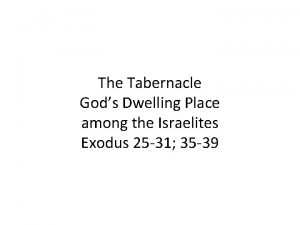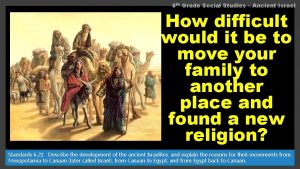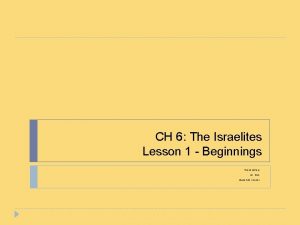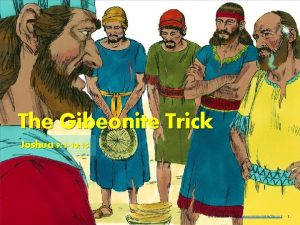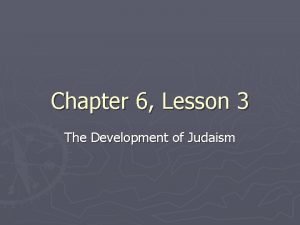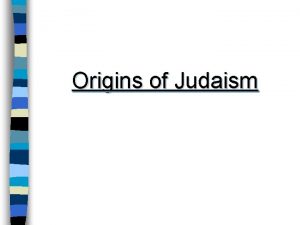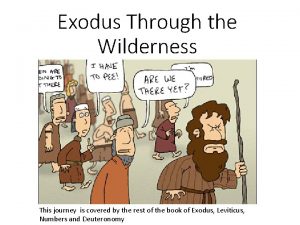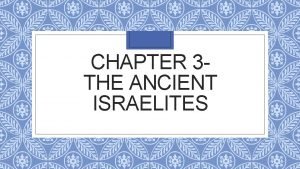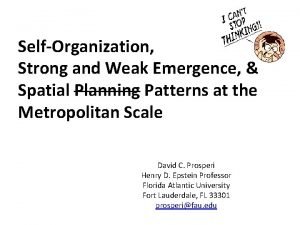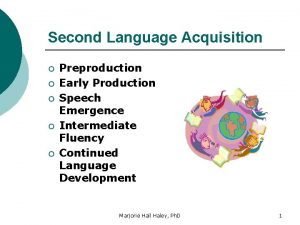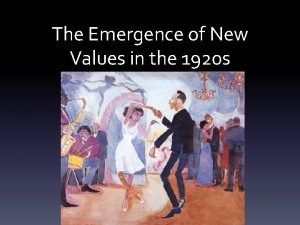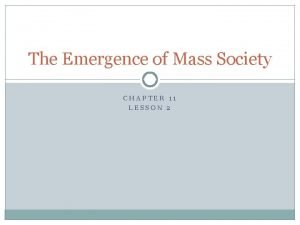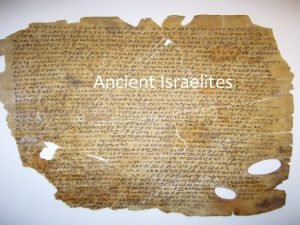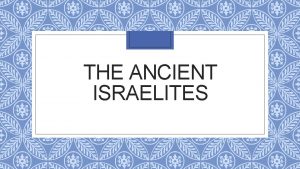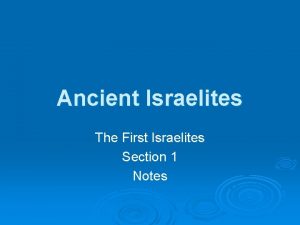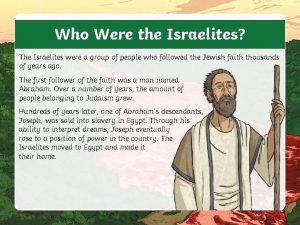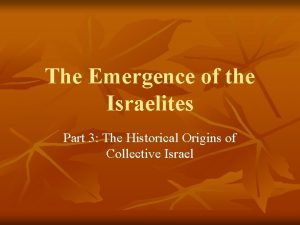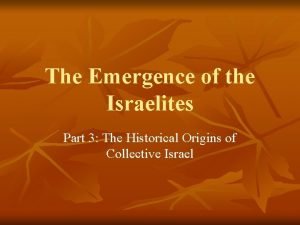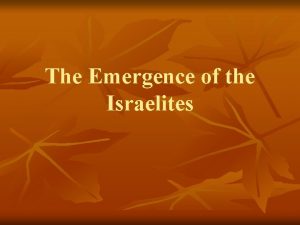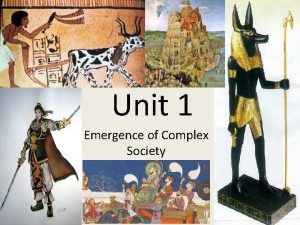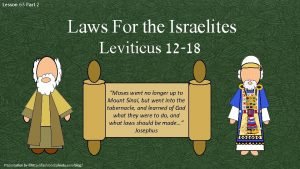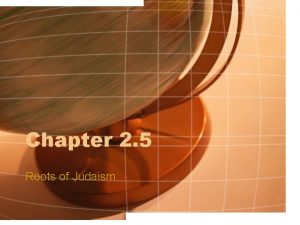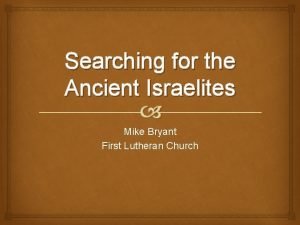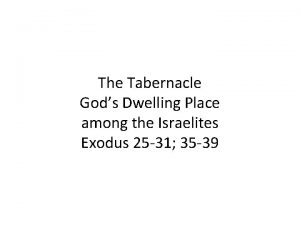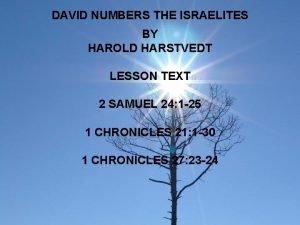The Emergence of the Israelites Part 3 The










































































- Slides: 74

The Emergence of the Israelites Part 3: The Historical Origins of Collective Israel

The Fertile Crescent. 2

Genesis 11. 27 -12. 9 3

Genesis 12. 10 -20. 4

Traditional Route of the Exodus between Egypt and the plains of Moab in Jordan. 5

Books of Exodus, Leviticus, Numbers, and Deuteronomy. 6

Books of Joshua and Judges. 7

8

The Israelites in Transjordan and at Gilgal, Jericho, and Ai. 9

Conquest – Central and South. 10

The Territories of the Tribes of Israel in the land of Canaan (Joshua 13. 1 -21. 45). 11

See Finkelstein and Mazar, The Quest for the Historical Israel, pp. 69 -98): B. B. Schmidt, A Summary Assessment for Part 3; I. Finkelstein, When and How did the Israelites Emerge? pp. 73 -83; A. Mazar, The Israelite Settlement, pp. 98. H. Shanks, ed. , Ancient Israel: From Abraham to the Roman Destruction of the Temple. Third Edition. Washington, DC: Biblical Archaeology Society, 2011, “The Settlement in Canaan: The Period of the Judges, ” pp. 59 -83. 12

Settlement of Israel in the Land of Canaan: - The books of Joshua and Judges are part of the Deuteronomistic History – a history written from the point of view of the Book of Deuteronomy or theology of the Deuteronomist: Deuteronomy provides a criterion by which to interpret Israel’s national successes and failures: - Obedience to the Mosaic Torah/Law ensures prosperity and divine protection; - Disobedience brings national defeat and death; 13

Theology of the Deuteronomistic History: Theology of this history may be summarized (Deut 28 -30): when Israel is faithful to Yahweh and follows the Torah/Law it will prosper (Deut. 30. 15 -20); when Israel sins, e. g. , mixing the cult of Yahweh with Canaanite elements, the nation will suffer national defeat; thus, a cycle: sin; punishment; repentance; forgiveness; restoration. (see Judges 3. 7 -11; 3. 12 -30; 4. 1 -5. 31; etc. ). 14

Settlement: - thus, the narrative on the settlement of Israel in the land of Canaan is a theological interpretation of history; - as a result, Finkelstein says that we must turn to archaeology and extra-biblical texts to learn about the emergence of Israel in the Central Highlands of Palestine in the 12 th-11 th century; - the Merneptah Stele: testifies to the presence of an “Israel” in Canaan in the late 13 th century BC; - archaeology provides evidence of a wave of settlement in the highlands of Canaan at about the same time. 15

16

Merneptah Stele – (granite stone) 17

Merneptah Stele: -Merneptah (1213 -1203 BC) (13 th son of Ramesses II); - the stele primarily commemorates a victory in a campaign against the Libu and Meshwesh Libyans and their Sea Peoples allies ( in Year 5…, that is, 1209/1208 BC); - however, final two lines refer to a prior military campaign in Canaan at the end of the 13 th century; - the conquest of three cities: Ashkelon, Gezer, and Yanoam; and - the annihilation of a group of people called “Israel”; - thus, evidence for the presence of a group by the name “Israel” in Canaan at this time (a people; not a country). 18

Merneptah Stele (size: 19

Route described on the 20

Sea Peoples – from New Kingdom Egyptian Reliefs. 21

Settlement: (See Textbook, pp. 69 -98) - Intensive archaeological surface surveys in the central hill country of Palestine and elsewhere; - reveal an entirely new settlement pattern in Iron Age I (1200 -1000 BC – traditional dating for the settlement); - hundreds of new, small sites were inhabited in the mountainous areas of the Upper and Lower Galilee, in the hills of Samaria and Ephraim, in Benjamin, in the northern Negev, and in parts of central and northern Transjordan (however, not in southern Transjordan); - can much of this activity be related to the “Israelites” or “proto-Israelites” (Bill Dever’s term)? 22

23

Tribal Allotment According to the Bible. 24

25

Settlement: - in Galilee: small agricultural villages ca. 1 acre in area; - at Hazor and Dan: occupational strata attributable to the Israelites? - in Lower Galilee; - in the Central Hill Country: evidence of intensive settlement: - largest villages were 10 -20 acres in area; - others ranged between 2 -5 acres or less; - in Ephraim: very small, extending from a few houses to 1. 00 -1. 50 acres of built-up area; - for example: Shiloh, `Ai, Bethel, Khirbet Raddanah, and `Izbet Sartah. 26

Map of Location of Sites in Israel 27

Tel Shiloh – Iron Age I site 28

Izbet Sartah in the Central Hill Country of Palestine. 29

`Izbet Sartah – Ground Level 30

`Izbet Sartah – Iron I, Stratum III. 31

Four-room house – lower segment – partly reconstructed. 32

Four-room house – interior (reconstructed). 33

34 House – typical stone built house in Jordan (not unlike Iron Age

Cistern - Ancient 35

Terracing 36

Terracing – Machu Pichu, Peru 37

Collared-rim jar 38

Collared-rim jars from the site of Dan (in the north of Israel) 39

40

Map of Location of Sites in Israel 41

Settlement: - In the land of Benjamin: - some 12 Iron Age I (1200 -1000 BC) sites, for example, Tell en-Nasbeh, Tell el-Ful. - In the hills of Judah: - sites attributable to the Israelite settlement are almost completely non-existent in the Hebron hills south of Bethlehem; - the site of Giloh, south of Jerusalem, is an exception. 42

43

44

Settlement: - In the region of Arad and the Beersheba Valley: - no Late Bronze Age settlements, and only a few sites established in the Iron Age I, for example, Tel Masos (a 20 -acre site); 45

Map of Location of Sites in Israel 46

47

Tel Masos – Iron Age I site 48

Tel Masos 49

Tel Masos – General Plan. 50

Tel Masos Houses 51

Route of the Arabian Spice Trade. 52

Settlement: -Population: 60, 000 according to Finkelstein; - however, according to Mazar, this population estimate must remain tentative (see pp. 86 -87 in textbook). 53

Settlement: - Many of the early Iron Age I agricultural settlements abandoned at the end of the 11 th century BC; - is this related to the concentration of population in the emerging towns in the period of the Monarchy, from the 10 th century onward? 54

Finkelstein’s Position on the Emergence of Israel: - Much in common with two previous waves of occupation in these areas; - processes of sedentarization and nomadization of indigenous groups in response to changing economic and socio-political conditions; - much of Iron I settlement was part of a long-term cycle; - the early Israelites/proto-Israelites were, in fact, Canaanites. 55

Finkelstein’s Position on the Emergence of Israel: - the outcome: the emergence of the Israelite and Judahite territorial states; -The historical emergence of the Israelite state around 900 BC in the northern highlands; - the biblical depiction of the rise of early Israel was shaped by the rise of the Judahite state in the late Iron II period; - this depiction cast by the Deuteronomistic Historian to serve Judah’s purposes; - the biblical narrative of the emergence of Israel held sway until archaeology came to the center stage of historical research on Canaan-Israel. 56

Mazar’s Position: - Nothing in the archaeological findings points to the foreign origin of the hill-country settlers; - a combination of components from all three theories on the Conquest/Settlement may explain the hill-country settlement as a complex process (see previous segment); 57

Mazar’s Position (contd. ): the origins of the groups could have been quite diverse: some could have been local pastoralists; others could have been pastoralists arriving from Transjordan or other parts of the country; the archaeological evidence appears to depict a settlement process involving tribal groups; possibly included are displaced Canaanites or immigrants from Syria, that is, refugees. 58

59

Mazar’s Position: - Who was responsible for the traditions concerning the sojourn in Egypt, the Exodus, Mount Sinai, and the figure of Moses? - perhaps the “Shasu of Se`ir” of the Egyptian inscriptions; - Shasu Yahwi: in Egyptian texts as well; - Yahweh comes from Seir, that is, Edom (Judg 5. 4, see also Deut 33. 2); - Shasu are related to Edom in the Egyptian sources; - Frank Cross: the “Moses group” migrated during the 13 th 12 th centuries BC from Egypt to Midian (see Exodus 2. 1522; 3. 1) then to Edom and Canaan bringing the new religion, Yahwism, with them. 60

Shasu mentioned in the Egyptian Texts of Seti I (1294/1290 -1279 BC). 61

Shasu prisoner as described on Ramses III’s reliefs on Madinat Habu 62

63

Traditional Route of the Exodus between Egypt and the plains of Moab in Jordan. 64

65

66

67

68

69

70

71

Conquest – Central and South. 72

73

Map of Location of Sites in Israel 74
 603 550 israelites
603 550 israelites Nsms 6th grade social studies.weebly
Nsms 6th grade social studies.weebly Chapter 6 the israelites
Chapter 6 the israelites Chapter 6 the israelites lesson 1 beginnings
Chapter 6 the israelites lesson 1 beginnings The gibeonites tricked the israelites at
The gibeonites tricked the israelites at Lesson 3 the development of judaism
Lesson 3 the development of judaism East river valley phoenicians and israelites technology
East river valley phoenicians and israelites technology Map of israelites journey to promised land
Map of israelites journey to promised land Chapter 6 lesson 1 the israelites
Chapter 6 lesson 1 the israelites Ancient israelites
Ancient israelites Map of the exodus and wilderness journey
Map of the exodus and wilderness journey Ancient israelites lesson
Ancient israelites lesson Emergence netflix
Emergence netflix Itero göteborg
Itero göteborg Emergence of scaling in random networks
Emergence of scaling in random networks Emergence of entrepreneurial class in india
Emergence of entrepreneurial class in india Emergence theory
Emergence theory So&e
So&e Speech emergence stage
Speech emergence stage The emergence of new values
The emergence of new values Lesson 2 the emergence of mass society
Lesson 2 the emergence of mass society Paul ruthman committee
Paul ruthman committee Plan emergence madagascar 2019-2023 pdf
Plan emergence madagascar 2019-2023 pdf Plan emergence madagascar 2019-2023 pdf
Plan emergence madagascar 2019-2023 pdf Intermediate fluency stage
Intermediate fluency stage Systemic game design
Systemic game design Mass society
Mass society Part to part variation
Part to part variation Addition symbol
Addition symbol Technical descriptions
Technical descriptions Part to part ratio definition
Part to part ratio definition Front bar parts
Front bar parts Part part whole
Part part whole The phase of the moon you see depends on ______.
The phase of the moon you see depends on ______. V cc
V cc Thẻ vin
Thẻ vin Thể thơ truyền thống
Thể thơ truyền thống Hát lên người ơi alleluia
Hát lên người ơi alleluia Sự nuôi và dạy con của hổ
Sự nuôi và dạy con của hổ Diễn thế sinh thái là
Diễn thế sinh thái là Vẽ hình chiếu vuông góc của vật thể sau
Vẽ hình chiếu vuông góc của vật thể sau 101012 bằng
101012 bằng Công thức tiính động năng
Công thức tiính động năng Tỉ lệ cơ thể trẻ em
Tỉ lệ cơ thể trẻ em Lời thề hippocrates
Lời thề hippocrates Vẽ hình chiếu đứng bằng cạnh của vật thể
Vẽ hình chiếu đứng bằng cạnh của vật thể đại từ thay thế
đại từ thay thế Quá trình desamine hóa có thể tạo ra
Quá trình desamine hóa có thể tạo ra Các môn thể thao bắt đầu bằng từ đua
Các môn thể thao bắt đầu bằng từ đua Hình ảnh bộ gõ cơ thể búng tay
Hình ảnh bộ gõ cơ thể búng tay Sự nuôi và dạy con của hươu
Sự nuôi và dạy con của hươu Thế nào là mạng điện lắp đặt kiểu nổi
Thế nào là mạng điện lắp đặt kiểu nổi Dot
Dot Biện pháp chống mỏi cơ
Biện pháp chống mỏi cơ Phản ứng thế ankan
Phản ứng thế ankan Chó sói
Chó sói Thiếu nhi thế giới liên hoan
Thiếu nhi thế giới liên hoan điện thế nghỉ
điện thế nghỉ Fecboak
Fecboak Một số thể thơ truyền thống
Một số thể thơ truyền thống Thế nào là hệ số cao nhất
Thế nào là hệ số cao nhất Trời xanh đây là của chúng ta thể thơ
Trời xanh đây là của chúng ta thể thơ Slidetodoc
Slidetodoc Hệ hô hấp
Hệ hô hấp Thế nào là số nguyên tố
Thế nào là số nguyên tố đặc điểm cơ thể của người tối cổ
đặc điểm cơ thể của người tối cổ Các châu lục và đại dương trên thế giới
Các châu lục và đại dương trên thế giới Glasgow thang điểm
Glasgow thang điểm ưu thế lai là gì
ưu thế lai là gì Tư thế ngồi viết
Tư thế ngồi viết Cái miệng xinh xinh thế chỉ nói điều hay thôi
Cái miệng xinh xinh thế chỉ nói điều hay thôi Các châu lục và đại dương trên thế giới
Các châu lục và đại dương trên thế giới Cách giải mật thư tọa độ
Cách giải mật thư tọa độ Bổ thể
Bổ thể Từ ngữ thể hiện lòng nhân hậu
Từ ngữ thể hiện lòng nhân hậu
